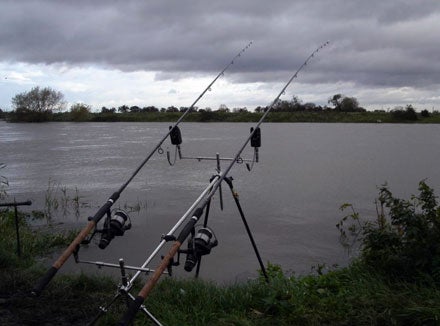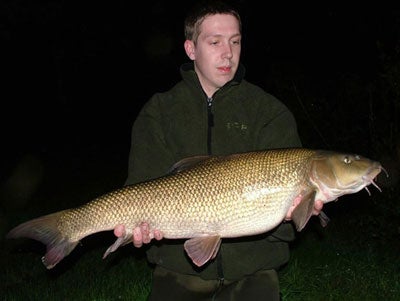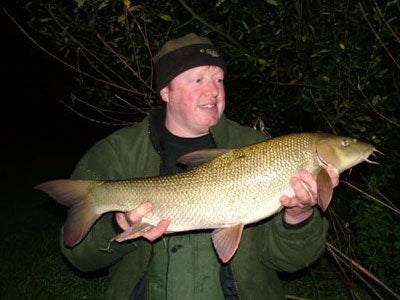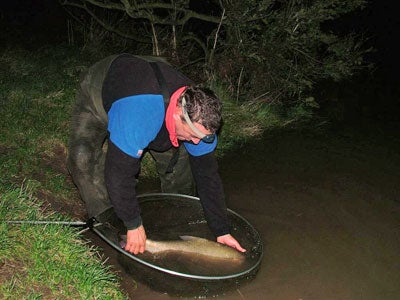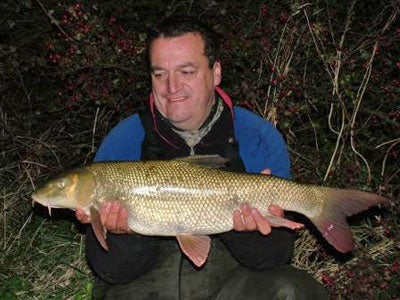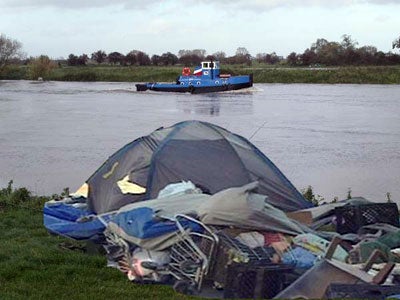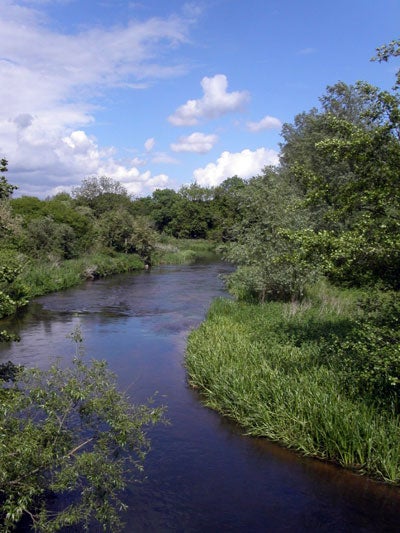Pictures by Adrian Kiddell, Tom Sayer and Richard Wells
PART 2 – STORM IN A TRENT SWIM By now we were into mid October and to be honest I was giving up hope on the Trent for the season, the trip from Norfolk seems all that much longer when confidence is low. In our favour the weather was still good and the long range forecast predicted the barbel anglers dream, south westerly wind and plenty of rain. I promised Ginger one more trip; he is a non driver so can ponce lifts for England. In this day and age most people can drive but if you seen Ginger ride a bike you would understand why he can’t drive a car. With conditions ideal Ginger managed to catch a couple of small Wensum fish, but as always most welcome. My turn came to fish Q8 (an area of the Wensum controlled by a syndicate with a no publicity rule). After missing a 3 ft pull of the rod tip I was gutted to blank when I know I had the chance to put a big ‘un on the bank. Saturday night was Tommy’s turn; he is frightened of the dark so myself and ginger held his hands as we walked through the woods to get to the swims. The river was in perfect condition with a little extra water and colour. A look in a couple of likely areas produced no interest so an area baited earlier was Tommy’s last chance. I don’t think his bait had laid on the bottom for many seconds when a small rattle of the rod top turned into a full scale lunge as Boris headed south. Certainly a big fish as it tested the tackle and angler to the limit. Tom was up to the challenge and all I had taught him became obvious as we slid the net under a monster at 14.8, an absolute corker but not a PB as the lucky sod had a 15.12 from the same swim last season. Well done Tom.
A Sunday night Trent session and a word of warning The next day Ginger and I had planned a Sunday night Trent session. Leave Norfolk early Sunday with plans to be fishing by noon. Riverline gave the river as over three foot up and rising, more like five foot when we got there and still rising. Now I am glad most people flee from these conditions, which is great as I love ’em and leaves more space on the river bank for me. We arrived to find the entire stretch deserted and the choice of any peg was ours. Ginger looked worried as he saw the first of the many large items of debris race past carried seaward by the current at a great rate of knots. Lets get the important and serious stuff out of the way first. Should you be going to fish a river in flood, don’t go alone as safety in numbers is the rule of the game. I also always like to position a marker (bank stick or similar) somewhere close to water level so a constant eye can be kept on the rate of rise or fall of the river. Be warned, rivers can rise at a frightening rate, having once been trapped by a rapidly rising Severn I speak from experience. Our old mate Ginger, well he can’t swim either so we usually tie him to a tree in these conditions. Do take care please when fishing in these conditions as slippery, muddy banks, cold, fast paced rivers, spell disaster and no fish is worth that. As always, when looking for swims when the river is carrying extra water, look for areas of more even paced water. The main flow will often be impossible to fish and areas of intense surface boils are not favoured by barbel. Take time to watch the river for several minutes and watch as its surface pattern changes and you will soon see a pattern develop, certain areas remaining almost flat with little alteration to the flow. These areas can be hotspots, and they’re sometimes no bigger than a table top and sometimes the size of a tennis court, often on the outside of bends. Myself and Ginger selected such an area on the outside of a bend. It was an area 10 to 20 yards out and around 50 yds long and was considerably slower than the rest of the surrounding river. We first of all had a chuck around with a gripper lead and found our chosen area was also an area of gravel. Before setting up camp for the night we decided to fish just one rod and see what was required to hold bottom and how much suspended debris we had to contend with. I chose the swim I fancied and ginger immediately put his gear down to ensure he would fish it – as always my mates in Team Barbel are followers not leaders; it’s a good job they got me as a guide and mentor or they would still be tiddler bashing on the Broads. While I sorted out the basics Ginger visited two anglers on a private stretch a few hundred yards upstream. Things were going well for them as they had had a couple of fish, the best a double at 10.4, but reckoned they needed 9ozs of lead to hold bottom! Ginger chucked out first with 4oz of lead and the essential back lead soon nailed his line and terminal tackle to the river bed out of the way of the suspended debris. He had hardly set his alarm when it screeched with delight as the first barbel of the session headed for Hull. Unfortunately a poor hookhold soon saw the fish win the battle for freedom, and Ginger muttered loudly under his breath. I was pleased to see at least fish were in the area and our confidence grew a few minutes later as Ginger again hooked but quickly lost another fish. I did not need convincing any more and set out my kit for the 24 hour session.
A glance at my safety marker told me the river was still rising at around an inch an hour so I ensured I was well back from the river in case it continued to rise. We use a pod on the Trent, a JRC model which allows us to fit extra long legs to the front giving us the high rod tip position we require without having to worry about getting bank sticks into the rocky banks. A pair of alarms and gripper back rests completes the ironwork. Baitrunner reels are a must as are a pair of suitable rods. Team Barbel all use Harrisons, they are faultless and a joy to use. Please you carp boys leave the heavy pokers you use for winding in your carp at home and get yourself a couple of suitable barbel rods, you will enjoy it much more. As for reel line, Diawa Sensor is cheap but very very good. I reckon 12lb for flood conditions and 10lb for anything else. Hooklinks for flood conditions need to be semi stiff to prevent tangles when the lead rolls. Ginger was not long getting his first fish in the net, it was only small at just over 5lb but as always a joy to catch. Very quickly Ginger had three fish and was becoming quite cocky as he doubted my ability, particularly as I had been having severe problems with my 2oz backleads getting stuck in the rocks which line the Trent in this area. Several words were uttered and a rod and reel was thrown up the bank in anger as the 5th backlead of the session was gobbled up by the rocks. The trick was to clip on the backlead then quickly flick it to clear the rocks and end up over the shelf and on the riverbed proper. This did the trick and we soon found it was not difficult to keep lines and hookbaits free from the debris. Ginger was now on four fish and me, well, my Trent curse was still with me. What could I do to break it? Little did Ginger know that not only had I a secret soak for my PVA bags but I also had a tub of lobworms and three on a size 4 soon sorted my first barbel of the trip but only my second of the season from the Trent. The river was still rising steady, no need to panic but an inch an hour meant we had to stay alert. As I suggested to Ginger that it was tea time the heavens opened and rain soon started to patter loudly on the skin of our shelters. Half an hour or so later the skies cleared and the wind freshened as I cooked us a beef curry and fried spud special. As darkness fell several large barbel dolphined over our baited area, which is always a good sign. The problem we had was the heavy leads crashing in and not allowing the fish to settle undisturbed on our baits. After a little thought we agreed to keep casting to a bear minimum and only recasting when essential, this had the desired effect as I quickly added four fish over 8lb to my haul. Ginger now had six but had lost five or six fish. It is essential when fishing with heavy leads and backleads to strike very firmly or hookholds may pull, as Ginger found out to his cost. The wind was now getting stronger and with little protection on top of the flood bank it would turn out to be a rough night. I held my shelter in place with four storm sticks and a guy rope and still feared for its ability to remain whole. Ginger fared little better but it did not seem to bother him so much as the only sound I could hear above the roar of the wind was Mr Zzzzzz himself snoring his bloody head off – and it was only 8 o’clock! As the night progressed a pattern emerged; neither of us had had a fish on our upstream rod even though my downstream rod had produced several fish. Ginger’s upstream rod was fishing a very similar area and had not produced, something that had not gone unnoticed before. Why I wonder should this be? It’s not unusual for it to happen and I often wonder if you would be better with just the one rod. Hell fire, did the wind blow at times! It was gusting to the point where I was unsure if the shelter could take much more, unfortunately if the wind eased then it poured with rain, but the fish kept coming. At around 1am, with the wind howling around, I was alerted to a screamer of a run to strike into what was obviously a good fish and after a real slog landed my first Trent double at 11 4. Even though the noise from the wind and rain would have woken the dead I had to wake Ginger to photograph the fish. As the session progressed fish still came steady.
I was woken from the semi asleep state I was in by a different alarm tone. My upstream rod top was held over and the bait runner was feeding line smoothly to a hooked fish. I picked up the rod and set the hook firmly. This felt like a good fish, fighting slowly but positively, as big fish seem to. I slowly made ground as the fish held bottom. My other rod came into play as the fish picked up the other line and I was now attached to a heavy fish with around 1lb of lead adding to my problems. With the downstream alarm singing a merry tune I hoped this would wake Ginger, but no, the noise of the wind and the fact he does not sleep but actually hibernates meant I had to sort this myself. Many years ago mother taught me to knit so I had no problem as I undid the knit one pearl one situation and finally netted my second double at 10.10. I woke Ginger from his coma for the photos and returned another awesome Trent barbel.
Ginger finished the session with eight fish, the best at 7.1. I had a cracker of a session with 12 fish, two doubles, another big nine and five more over eight. After having only one Trent barbel so far this season I was well chuffed to have had such a terrific bag of fish, with a couple of doubles for good measure. The wind had now eased as we washed down a mountain of bacon rolls with several mugs of hot tea. That awful trip back to Norfolk even seemed acceptable after such a great session.
Back to the Wensum A couple more sessions on the Wensum and Ginger upped his doubles count with another nice fish at 11 1. These Wensum fish certainly have grown. What a beautiful little river the Wensum is and it is now even better for barbel than in the heydays of Messer’s West, Miles and Plummer. The downside is in the main it is private and fishing is very strictly controlled. A few day ticket and public banks do exist with the odd barbel to be caught.
As I write this the clocks have changed and I always think that spells the end of the summer style of barbel fishing, with the first frost chilling the rivers to a level at which Boris has a lesser urge to feed as their metabolism slows and care must be taken not to overdo the feed. But roll on some wild weather and a good south westerly blow, and those in the know will be back on the bank with the knowledge that the barbel will be hungry. If a bit of wild weather does not worry you lads watch out for these conditions, get out there and enjoy it, but don’t go alone though after heavy rain and floods the steep banks of the Severn and Trent can be treacherous. A 200lb bag from the Trent in November All this and more in ‘Team Barbel On Tour Part 3 – The High Pressure Blues’. Coming soon. Without doubt fishing memories are not made without great mates and I got two of the best in Tommy (Tom Sayer) and Ginger (Richard Wells) |
Welcome!Log into your account










